Homemade Canned Spaghetti Sauce {Step-by-Step Tutorial}
Using garden fresh tomatoes, this delicious homemade canned spaghetti sauce recipe is super easy to make (step-by-step pictures below) and so flavorful!
Long promised, I’m finally sharing the homemade canned spaghetti sauce recipe that will adequately take care of all those lingering fresh garden tomatoes!
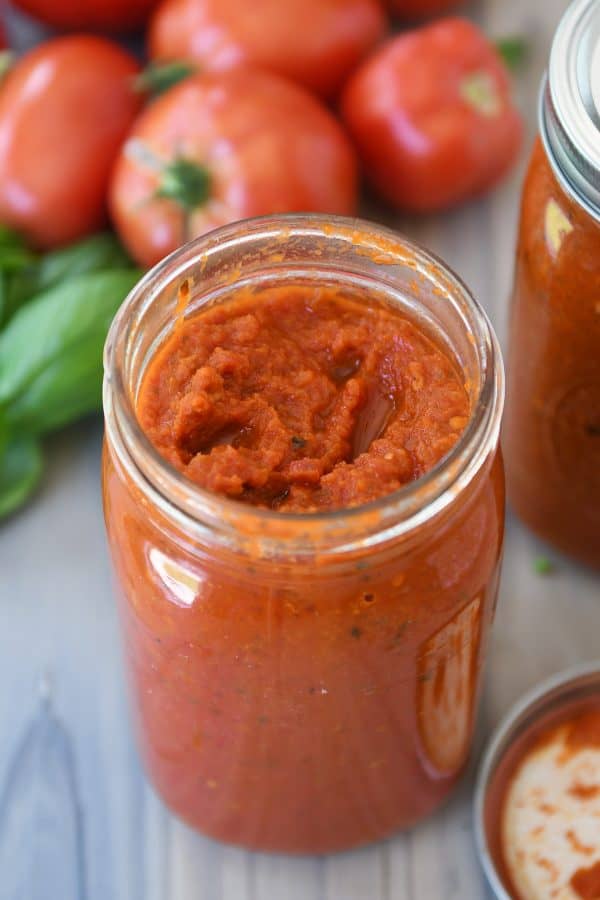
Below is a step-by-step guide to making and canning this marinara sauce along with some general details about canning to help out any beginners interested in getting started.
This sauce is thick and hearty with a rich flavor that suits everything from topping a simple plate of pasta or using in recipes that call for jarred spaghetti sauce.
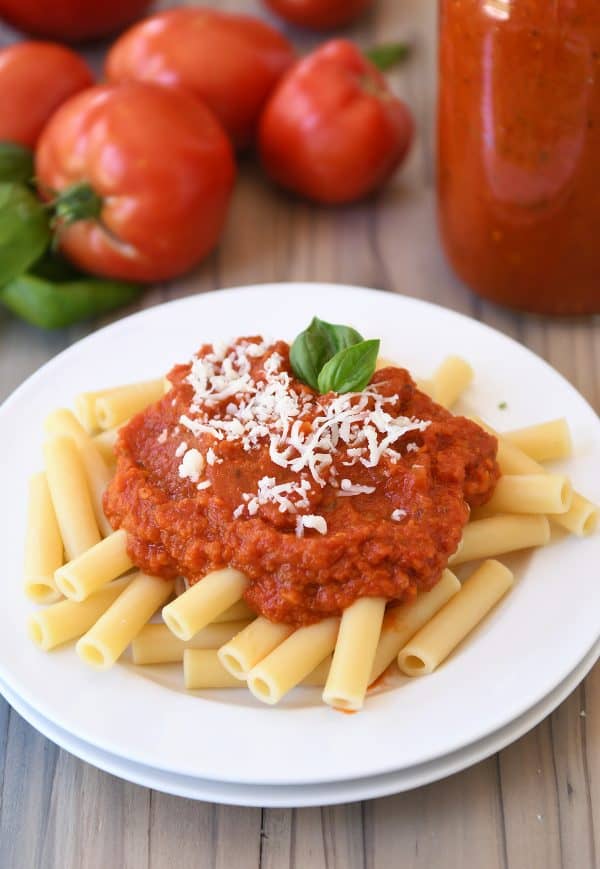
As you may already know, I have a tried-and-true, decades old homemade spaghetti sauce I use regularly for family spaghetti dinners (and a faster weeknight spaghetti sauce), but neither of those have been tested for canning safety.
That’s where this homemade canned spaghetti sauce recipe comes in! While the flavor profile of this canned version is a little different from the above favorites, it is delicious in its own right.
Plus, it’s just plain satisfying to see how fresh tomatoes can turn into something so splendid. Basically, you’ll feel like a canning rock star in no time.
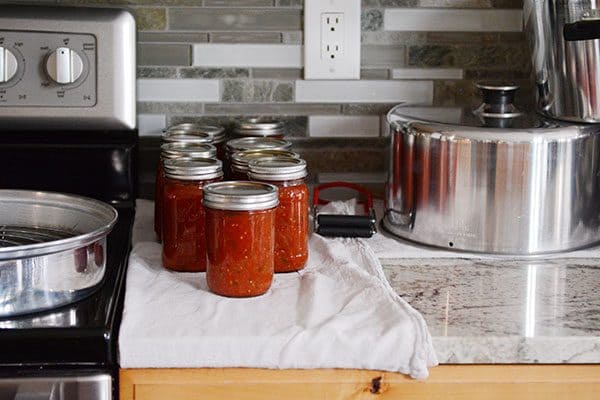
Let’s start with a few canning basics. Here are a few posts I’ve done in the past that help demystify home canning:
Canning 101: Water Bath Canning Basics
Small Batch Canning 101
Below in the tutorial for this homemade canned spaghetti sauce recipe, I’m using a steam bath canner. It processes the same high-acidity foods as a water bath canner but uses a lot less water and is less bulky.
You can learn more about it in this post (why I use it, if it’s safe for canning, etc.). There also an article on the National Center for Home Food Preservation about steam canners here.
What Canning Tools Are Needed for Homemade Spaghetti Sauce?
*affiliate links included below for products I’ve purchased from Amazon
-this over-the-sink colander is awesome for draining the tomatoes
-my trusty Breville food processor does all the chopping
–steam bath canner (with dial on top for accurate safety)
-this simple canning toolset has just about everything I need for filling and handling the jars (I also have this extra canning funnel with measurements; I use it every day to strain kefir but it doubles as a great canning tool)
Now let’s get started!
To make this canned spaghetti sauce recipe, you’re going to need about 18-19 pounds of fresh tomatoes, which is right around 60 tomatoes.
I use a mix of Roma (paste) tomatoes and every day garden tomatoes (I think I have early girl in my garden this year which I used for this recipe).
Peeling the Tomatoes
The more traditional method of removing the skins from the tomatoes involves plunging the tomatoes into boiling water and then plunging again into ice water.
I can’t bring myself to mess with that after I learned about the broiling method (which I talk about here in this popular homemade canned salsa recipe post).
Broiling the tomatoes to remove the skins is super easy. Cut the tomatoes in half, cram them in a single layer on a sheet pan and put them under an oven broiler for a couple of minutes until the skins wrinkle.
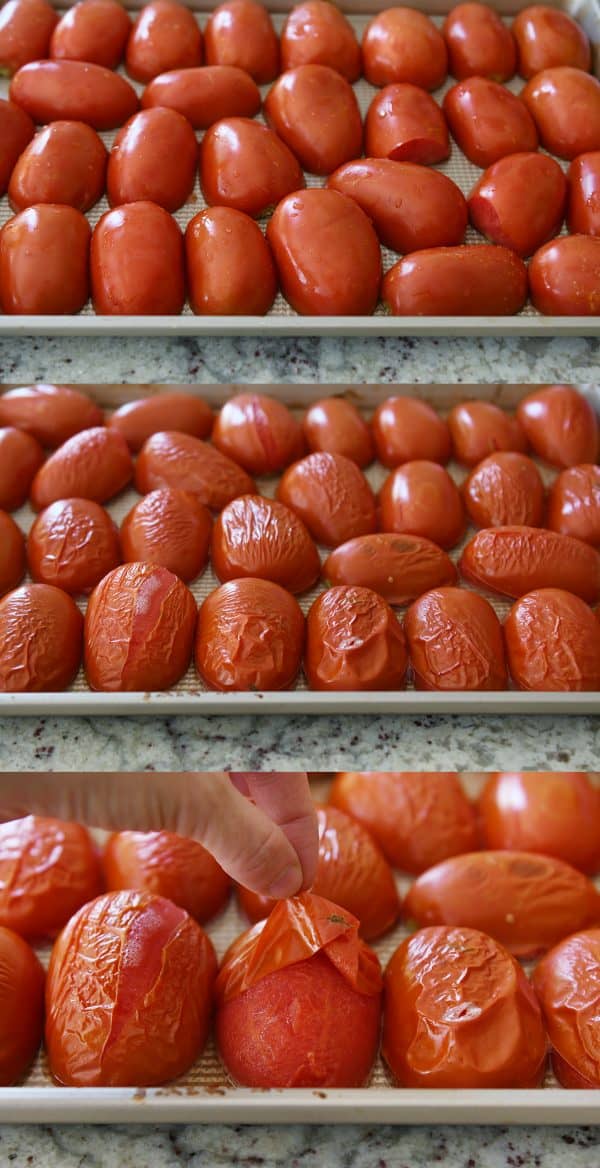
Once the tomatoes come out and cool for a minute, those skins will peel right off, and the sheet pans are super easy to clean!
I’ve heard you actually don’t need to remove the peels of the tomatoes – but keep in mind, they can be bitter and give an off-taste to the recipe you are using if you leave them on (and I have read on a couple sites that the skins may mess with the canning pH level, but I’m not 100% sure about that).
Draining, Chopping, and Measuring the Tomatoes
After the skins come off (go ahead and discard them), place the tomatoes in a colander set over a bowl or the sink and let them drain for 30 minutes to an hour until most of the watery liquid has drained off.
You can speed up this process by using your hands to mash and squeeze the tomatoes (did that just sound weird to anyone else?)…or a spoon works too.
You can see the before and after below.
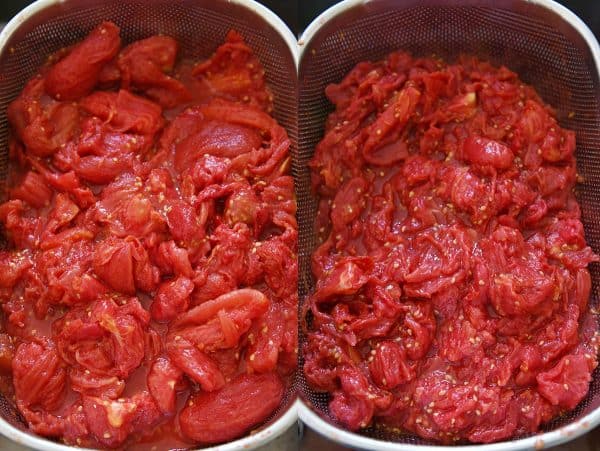
I throw the tomatoes in the food processor and give them a whirl until they are pretty well blended (I also use the food processor to chop up the peppers, onions, and garlic, too – makes it so easy and saves me White Knuckle Knife Syndrome from all that chopping).
Measure the tomatoes after they have been drained and chopped.
Simmer the Spaghetti Sauce
Combine all the ingredients for the spaghetti sauce except the lemon juice in a pot.
Stir well so the tomato paste doesn’t clump up and sink to the bottom. Burned tomato paste flavor throughout your sauce, and you may hate me forever.
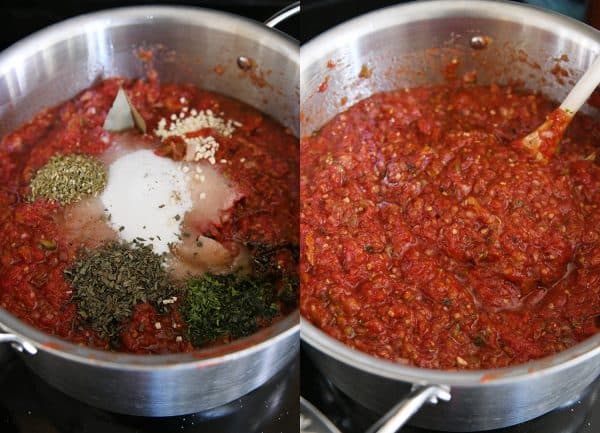
Bring the spaghetti sauce to a simmer and let it cook for about an hour. It should be nice and thick. If it is still really watery, let it simmer longer.
I use my immersion blender to get in there and smooth out any large chunks. The level of puree at this point is totally up to you (and you can also use a regular blender and process in batches, if needed – just take care blending the hot mixture).
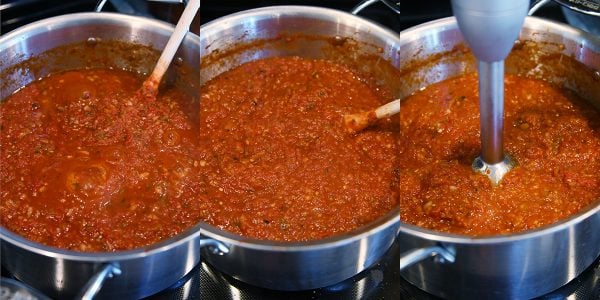
Here’s a quick little tip: while the spaghetti sauce is simmering, I get my steam bath canner filled with water and heating up on another burner. While it heats, I place the clean canning jars I’m going to use on the steam canner, cover with the lid, and let the jars steam and sterilize while the spaghetti sauce simmers.
Fill the Jars
Pour two tablespoons of bottled lemon juice into sterilized and hot quart sized jars (this recipe makes about 4 quarts). Fresh lemon juice isn’t recommended as the acidity level of fresh lemons can vary.
Now ladle in that sauce!
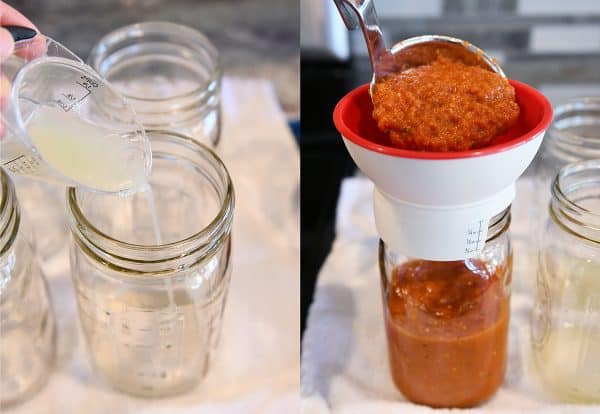
Wipe the rim of the jar clean with a damp cloth and put on a canning lid and ring (don’t over tighten).
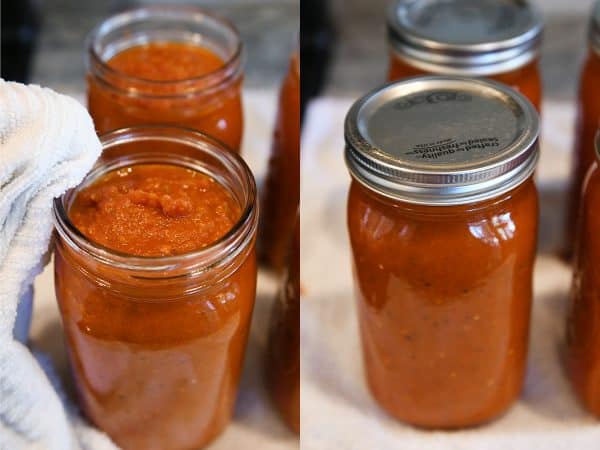
Process the Spaghetti Sauce
Process the quart jars for 40 minutes in a steam bath or water bath canner, adding time as needed for higher elevation (1,001 – 3,000 feet add 5 minutes; 3,001 – 6,000 feet add 10 minutes; 6,001 – 8,000 feet add 15 minutes).
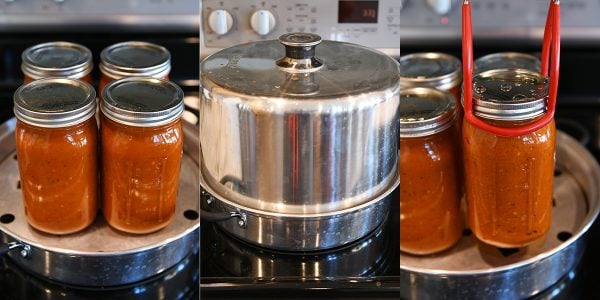
Once the jars have finished processing, carefully transfer them to a cooling rack or a towel set on the counter and let them cool naturally to room temperature…and wait for that beautiful pinging sound to let you know the jars have sealed (best sound in the world!).
And there you have it! Delicious, rich, hearty homemade canned spaghetti sauce!
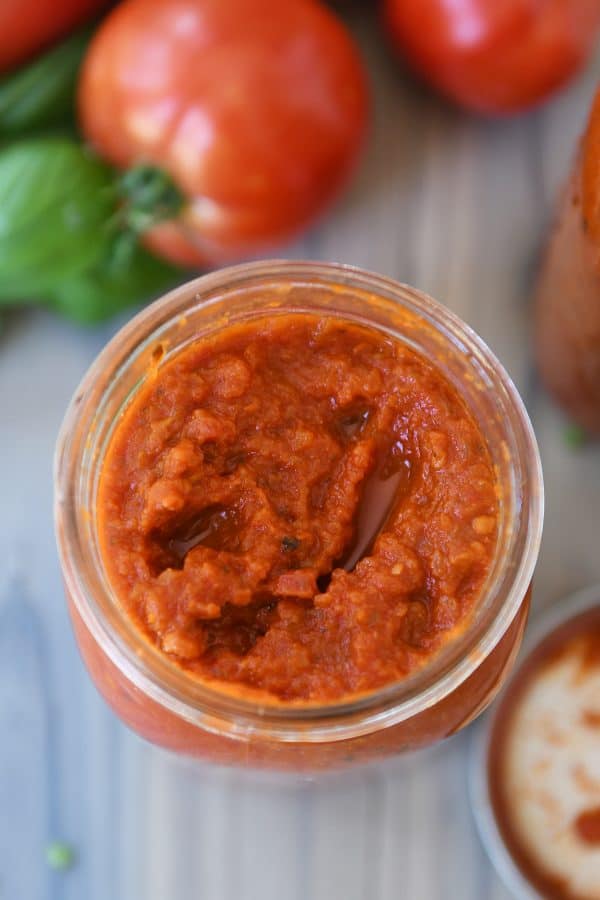
A Note About Canning Safety and Experimenting
I love home canning! And I love sharing canning recipes with you.
I actually experiment a lot with canning different things at home – trying new recipes and getting creative with ingredients and flavors. But when it comes to actually sharing those recipes with you, my beloved readers, I won’t post my recipe experiments, as delicious as they may be.
I’ll only ever share recipes that have been adequately tested for canning safety (pH levels) or that follow safe canning guidelines. That keeps both me and you safe.
But it also means that creativity (and yes, sometimes flavor) can be thwarted a bit. Canning safety dictates that a certain amount of acidity be included in a recipe for safe water bath/steam bath canning. And messing around with adding and decreasing ingredients (especially high or low acid ingredients) can compromise the safety.
I’ve made many other spaghetti sauce recipes for canning over the years. Some very delicious ones actually (several of you have sent me your favorites), but most of them have not been tested for canning safety, which means I can’t in good conscious share them.
Canning safety isn’t something to mess around with when sharing recipes with millions of people, if you know what I mean.
The good news is that recipes like today’s home canned spaghetti sauce are delicious and widely recognized to be safe to can at home. Phew! A tried-and-true canned spaghetti sauce recipe to hold on to forever.
Now, enough reading, let’s get canning!
One Year Ago: Cheesy Baked Ziti {Make-Ahead/Freezer Meal}
Two Years Ago: The Best Homemade Salsa {Fresh or For Canning}
Three Years Ago: Portillo’s Chopped Salad with Sweet Italian Dressing
Four Years Ago: Peanut Butter Granola
Five Years Ago: Chocolate Zucchini Cake with Brown Sugar Streusel
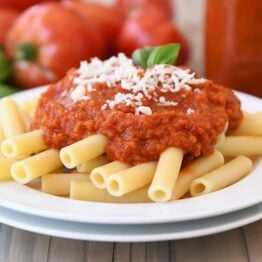
Homemade Canned Spaghetti Marinara Sauce
Ingredients
- 12 cups peeled, drained, and chopped tomatoes (see note)
- 1 cup finely chopped green bell pepper, about 1 large pepper
- 1 cup finely chopped red bell pepper, about 1 large pepper
- 2 cups finely chopped white or yellow onions, about 3 medium onions
- 3 cans (6-ounces each) tomato paste
- ½ cup vegetable or canola oil
- ¼ to ½ cup granulated or brown sugar
- 3 tablespoons salt, I use canning salt, see note for options
- 2 tablespoons finely minced garlic, about 6 cloves
- 1 ½ tablespoons dried oregano
- 1 ½ tablespoons dried basil
- 1 ½ teaspoons dried parsley
- 2 teaspoons Worcestershire sauce
- 1 bay leaf
- ½ cup bottled lemon juice
Instructions
- Combine all the ingredients except the lemon juice in a large 8-quart pot, stir to combine well, and bring to a boil. Reduce the heat and simmer for 1 hour, stirring often. Take out the bay leaf and discard. For a smoother consistency, use an immersion blender or transfer the sauce to a blender to process until smooth (optional).
- Pour 2 tablespoons of lemon juice into the bottom of sterilized, hot quart jars. Ladle in spaghetti sauce within 1/2-inch of the top. Wipe the rim of the jar with a clean, damp cloth. Place a canning lid and ring on each jar.
- Process the spaghetti sauce in a water or steam bath canner for 40 minutes (add 5 minutes if you live at 1,001 to 3,000 feet – if you live at higher elevation than that, you’ll want to use a water bath canner since steam bath canners shouldn’t be used to process jars longer than 45 minutes).
- Remove the jars carefully from the water or steam bath and let cool to room temperature. Check to make sure the jars have sealed correctly (lightly press the top of the lid; it should be firm – if the center bubbles up and down when you press on it, it hasn’t sealed correctly and will need to be refrigerated or re-processed).
Notes
Recommended Products
Recipe Source: used this recipe as inspiration and cut down quantities to make 4 quarts (without compromising acidity levels)

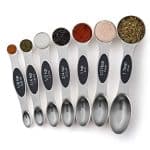
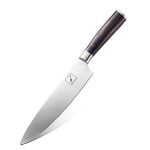
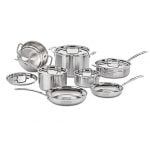
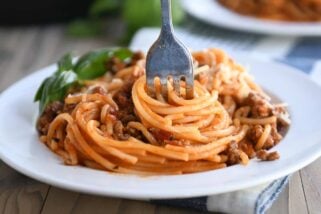
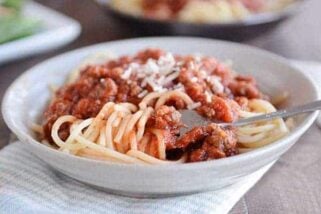
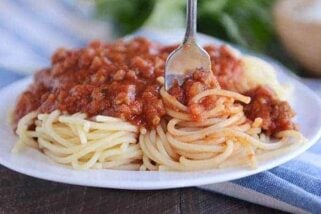
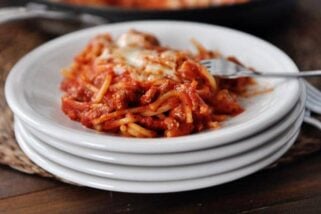
Can i leave out the onions? Im allergic to onion
The flavor will change, but yes, the onions can be left out without affecting canning safety.
I made this yesterday. Tasted party way through the cooking process, felt like it was missing something. Added 1 1/2 tsp rosemary, dried, and made all the difference. I canned 5 & 1/2 qts.
I tried different sauce recipes before but never liked them…. Then I found this one and it’s delicious! I get so many compliments! No need to look any further for the BEST sauce!
Very happy to hear that – thanks, Jen!
How long can this be stored on your shelf?
It’s recommended to use within a year.
Oh my gosh!!!! I’ve been making the Mel’s canned salsa for years, and absolutely love it. This year we had an abundance of tomatoes (Big Boys) and just canned up the spaghetti sauce recipe. I followed the recipe EXACTLY and is is to die for!!! I’m so excited that I’m going to hit a farmer’s market this weekend for more tomatoes!!!
So happy to hear you liked this spaghetti sauce, Bonnie! Thanks for letting me know!
I forgot that it was after I heated the sauce for 1 hour that I could blend it. I blended it while cold before cooking it. Will that be a problem?
That should be ok.
Hi Mel,
I picked your recipe from probably a dozen, mainly because I had all the ingredients and yours has abundant reviews. Voila! First time canning with large Romas and the thick sauce tastes great! I boiled and simmered probably 30 minutes more. Quartered tomatoes and sliced some with a paring knife at end. Didn’t want chunky sauce so I employed my processor and pulsed hot portions 10 seconds. Smooth! Pleasing taste.
My only goof was waiting til 10:30 pm to process after watching football.
Thanks for the review and comment, John! And glad I’m not the only one who starts canning that late at night, haha.
Do you think I could add a couple jalapeños to the recipe without affecting safe canning? Love the sauce and husband would like a little heat.
Unfortunately, peppers are a low acid ingredient and it isn’t recommended to add low-acid ingredients to water bath/steam bath canned recipes so that the pH stays in the safe level.
If not canning and just going to eat it, do I still use the lemon juice?
No, the lemon juice isn’t necessary if the sauce isn’t getting canned. (But it will affect the overall flavor of the sauce to leave it out – you can always add it, to taste, if needed).
Can I reduce the amount of onions? Or can I increase the amount of peppers as a substitute?
Yes, you can reduce the onions. It’s not recommended to increase the amount of any low acid ingredient (like onions and peppers).
Hi Mel! I’ve been stashing extra tomatoes in the freezer. Do you think I could chop them up and use them in this recipe?
I did this last year and it worked great!
Yes! That should work great. And bonus, the frozen tomatoes, once thawed, will be easy to peel (the skins fall right off).
What do you use to strain your tomatoes? I use a norpro food processor and then a couple strainers but not super efficient. Was wondering what you do or has worked best.
I use an over the sink colander that has fairly small holes. Seems to work ok, although I do toss the tomatoes a couple times.
Hi Mel, NW MT here and im thinking I should prob water bath can if I do this because im about 3000ft –> 2956′, and process for 45 minutes. Im new to canning tomatoes so correct me if im wrong.
Id like to roast some or all of the veggies(i have frozen tomatoes so idk how well that would work). Does roasting in amy way mess with acidity?
Also can I use cherry tomatoes? Mostly have Romas. Thank you!
Hi Danae, you can use a steam bath canner as long as the processing time doesn’t exceed 45 minutes. I’m not sure about roasting the tomatoes prior to using. I think it should be fine, but it might be best to consult your local extension agency to ask to make sure. Yes, you can use cherry tomatoes, but because cherry tomatoes are too small to have the skins removed, the texture/flavor of the sauce may change.
Hello!
Can I do a mix of romas, big/better boys and cherry tomatoes for this?
Im at 2900ft in elevation, would you just recommend to pressure can this then?
-> If I pressure can I can omit the L.Juice right?
Also, is it ok to roast everything and then imm. Blend in 1 big pot?
Thank you!!
Danae
Hi Danae, yes, you can use a mix of tomatoes. If you are wanting to pressure can the sauce, it might be best to search for a reputable recipe that’s been tested for pressure canning.
This is my go-to canning recipe. Delicious sauce, so fresh-tasting!
Hello Mel, I love your recipes and appreciate you so much!!
We froze all our garden tomatoes and now plan to make this sauce recipe. Just wondering if it would be okay to substitute olive oil for the canola oil? Thanks and Happy New Year!!
Hi Anne – I think it should work fine, but I hesitate to give advice to change canning recipes.
My previous message was inaccurate. It should read: can I omit the oil? I googled can I use olive or avocado oil instead and it said to not use oil in the canning process.
Can I omit the olive? I googled if I could. Or avocado oil and it said, I should not use oil at all in the canning process. It said I could add oil later when reheating. What are your thoughts on this?
Yes, you can omit the oil (keeping in mind that omitting any ingredient may make a difference in the final product).
I’ve made this twice now and it’s so good! My family loves it, making another batch today. Hubby just picked fresh tomatoes from the garden. Feeling very blessed!
Do you remove the juice and seeds of the tomatoes?
I don’t remove the seeds. But the tomatoes do need to be drained per the recipe/notes.
I screwed up and accidentally added the lemon juice to the pot…even though I read it 3 times and it said not to lol. Anyway to save it or are we eating spaghetti for the next week lol
Hi Summer…honestly, I’m not sure. To be safe, you might just freeze this batch.